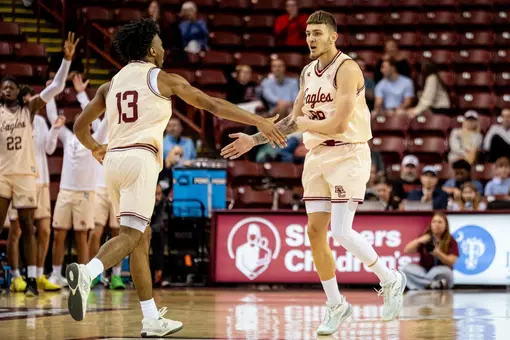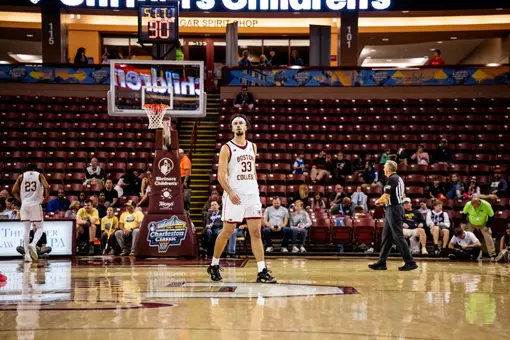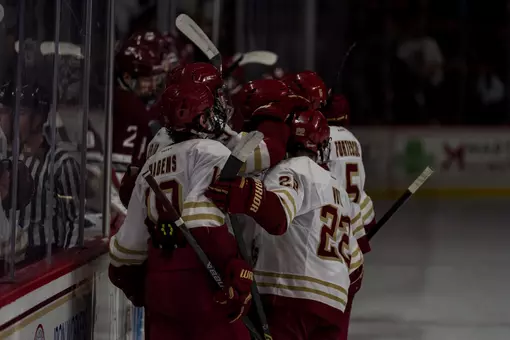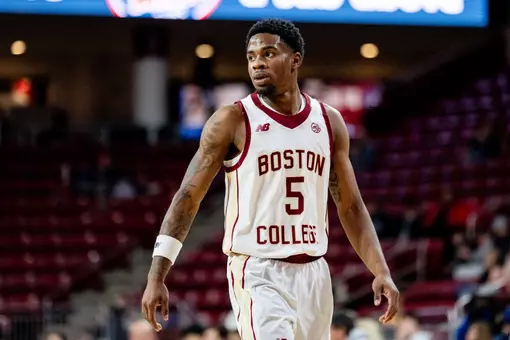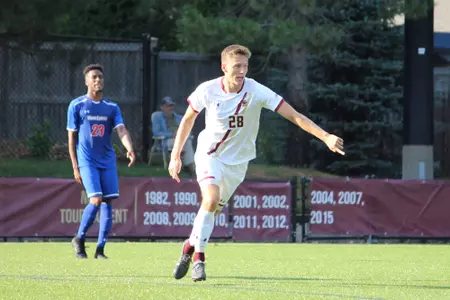
Working Now for Success Later
April 22, 2019 | Men's Soccer, #ForBoston Files
Men's soccer won three spring competition matches as part of its training regimen.
The 2018 Boston College men's soccer season ended with a resounding understanding of the ACC's margin of error. The team went 4-8-4 and lost to NC State in the first round of the conference tournament, but the players and coaches all knew things could have been different. Six of those defeats, after all, had been in one-goal games, and all had come against teams ranked in the national polls.
The year ended with that understanding: the Eagles could compete with the best but had to learn how to defeat those teams to return to the mantle of a national tournament contender. So as this year's spring training competition schedule dawned, that became the primary objective of a refocused and rededicated Boston College squad anxious to take its place back inside the top tier of college soccer squads. And thanks to three victories over stiff competition in its spring schedule, optimism is starting to root itself in the Eagle locker room.
It's a spring structure that's changed entirely thanks to U.S. Soccer, which introduced a College Development Program last year as a collaboration between the governing body and the NCAA. It created a league play format featuring the approved FIFA time format of 90 minute matches with 18 active roster spots and three substitutions. North Carolina won the 2018 championship in a six-team league that featured five ACC programs, and the success of the program inspired U.S. Soccer to expand it to two divisions this spring.
The expansion included Boston College as one of eight ACC teams, and the Eagles slotted into a North Division with Connecticut, Providence, Rutgers and Syracuse. The teams played off against one another and crowned a champion even as the NCAA considered the matches part of an exhibition schedule.
It became a jumping off point for the Eagles, who added an extra game outside "league play" against Boston University. They won three overall matches, including a 4-1 victory over the Terriers, as part of the foundation construction process for the 2019 regular season.
"It's made the spring more competitive," associate head coach Bob Thompson said. "And it makes the games worth something. U.S. Soccer oversees everything, and there are a few other leagues cropping up (throughout the country). The games are still considered an exhibition by the NCAA, but it allows the players to continue playing for something that will mean something."
It was an evolution of BC soccer in some respects. The Eagles always possessed the ball well last year, but this spring became about using that possession as a base of attack. With that in mind, BC's intention became about playing more efficiently and using that base to become more tactical up field with more pressure on opposing defenses.
It's a style attaching itself nicely to the Eagles' mentality. A number of players excelled within that style and took personal jumps as the chemistry developed. Rising senior Adam French scored a couple of goals in the spring competition, and rising sophomore Kristofer Konradsson continued to build on his ACC All-Freshman team campaign last fall. It's combined with the reemergence of Rafael Salama, a Spanish-born senior who started 15 matches in 2017.
"There were a number of new faces last fall," Thompson said. "So going into the spring allowed for more time, for the players to get more chemistry. Last year's team had a number of freshmen and transfer players that saw time together, so this is allowing them to continue gelling together as one."
It's the first leg of a trip that will eventually deliver the Eagles into their fall schedule. Spring practice concluded, but training season doesn't stop for the summer months. The United States Soccer Pyramid's fourth tier includes the United Soccer Leagues' League Two, and its four-conference setup has over 70 teams available for amateur athletes.
BC's soccer players will fan out into that tier, which used to be widely recognized as the Premier Development League, with the intention of continuing their training before returning to Chestnut Hill in August.
"We expect everyone to be fit in the fall," Thompson said. "There's a summer program that we have for all of our players. A number of the players will train in the USL Two, which is a new tier that's similar but improved (compared to) the Premier Development League. There's a message from the coaches that we want our mentality to get better, to keep building. We expect to be back in the NCAA Tournament, and that's realistic given the talent of players that we have (in this program)."
The year ended with that understanding: the Eagles could compete with the best but had to learn how to defeat those teams to return to the mantle of a national tournament contender. So as this year's spring training competition schedule dawned, that became the primary objective of a refocused and rededicated Boston College squad anxious to take its place back inside the top tier of college soccer squads. And thanks to three victories over stiff competition in its spring schedule, optimism is starting to root itself in the Eagle locker room.
It's a spring structure that's changed entirely thanks to U.S. Soccer, which introduced a College Development Program last year as a collaboration between the governing body and the NCAA. It created a league play format featuring the approved FIFA time format of 90 minute matches with 18 active roster spots and three substitutions. North Carolina won the 2018 championship in a six-team league that featured five ACC programs, and the success of the program inspired U.S. Soccer to expand it to two divisions this spring.
The expansion included Boston College as one of eight ACC teams, and the Eagles slotted into a North Division with Connecticut, Providence, Rutgers and Syracuse. The teams played off against one another and crowned a champion even as the NCAA considered the matches part of an exhibition schedule.
It became a jumping off point for the Eagles, who added an extra game outside "league play" against Boston University. They won three overall matches, including a 4-1 victory over the Terriers, as part of the foundation construction process for the 2019 regular season.
"It's made the spring more competitive," associate head coach Bob Thompson said. "And it makes the games worth something. U.S. Soccer oversees everything, and there are a few other leagues cropping up (throughout the country). The games are still considered an exhibition by the NCAA, but it allows the players to continue playing for something that will mean something."
It was an evolution of BC soccer in some respects. The Eagles always possessed the ball well last year, but this spring became about using that possession as a base of attack. With that in mind, BC's intention became about playing more efficiently and using that base to become more tactical up field with more pressure on opposing defenses.
It's a style attaching itself nicely to the Eagles' mentality. A number of players excelled within that style and took personal jumps as the chemistry developed. Rising senior Adam French scored a couple of goals in the spring competition, and rising sophomore Kristofer Konradsson continued to build on his ACC All-Freshman team campaign last fall. It's combined with the reemergence of Rafael Salama, a Spanish-born senior who started 15 matches in 2017.
"There were a number of new faces last fall," Thompson said. "So going into the spring allowed for more time, for the players to get more chemistry. Last year's team had a number of freshmen and transfer players that saw time together, so this is allowing them to continue gelling together as one."
It's the first leg of a trip that will eventually deliver the Eagles into their fall schedule. Spring practice concluded, but training season doesn't stop for the summer months. The United States Soccer Pyramid's fourth tier includes the United Soccer Leagues' League Two, and its four-conference setup has over 70 teams available for amateur athletes.
BC's soccer players will fan out into that tier, which used to be widely recognized as the Premier Development League, with the intention of continuing their training before returning to Chestnut Hill in August.
"We expect everyone to be fit in the fall," Thompson said. "There's a summer program that we have for all of our players. A number of the players will train in the USL Two, which is a new tier that's similar but improved (compared to) the Premier Development League. There's a message from the coaches that we want our mentality to get better, to keep building. We expect to be back in the NCAA Tournament, and that's realistic given the talent of players that we have (in this program)."
Players Mentioned
Men's Basketball: Harvard Postgame Press Conference (Nov. 26, 2025)
Wednesday, November 26
Women's Basketball: Merrimack Postgame Press Conference (Nov. 25, 2025)
Tuesday, November 25
Football: Head Coach Bill O'Brien Media Availability (November 25, 2025)
Tuesday, November 25
Football: KP Price Media Availability (November 25, 2025)
Tuesday, November 25

